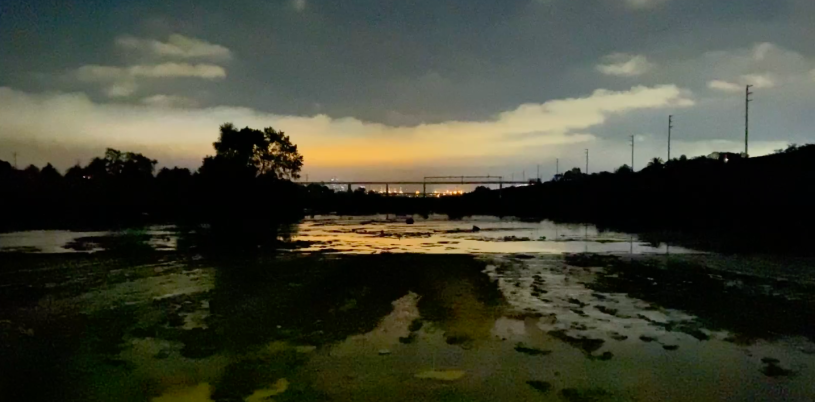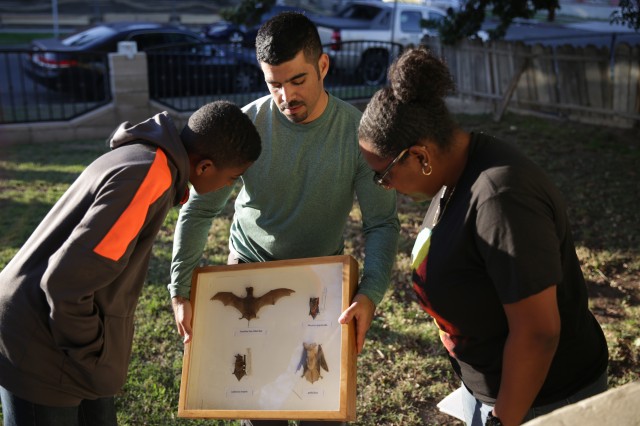Out of an abundance of caution for the safety of our visitors and staff, the museum will be closing at 3 pm on December 24 due to the impending storms. The museum will be closed Thursday, December 25 for the Christmas holiday. We will reopen Friday, December 26.

Published July 13, 2022
Commuters whiz towards their weekends on the overpass above our heads while the L.A. River gurgles beneath our boots along concrete banks into the vanishing light. A hand shoots up, as silent as our quarry and we note the time: the first bat sighting of the evening.
Four of us stand sentinel beneath likely bat roosts, narrow spaces between the concrete blocks beneath the overpass. A fifth member of our party trudges back and forth between us capturing the bats' ultrasonic calls on a bat detector—a high-frequency recording device. For some time after sunset, the magic hour will perfectly backlight the crevices, illuminating bats as they descend for the night. That’s the hope at least. We’re looking for bats, but it’s not a sure thing.
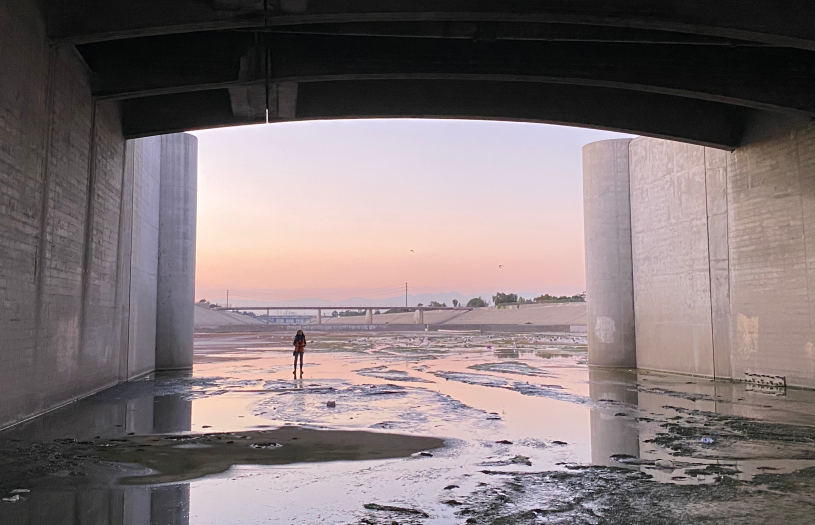
Every Bat Counts
We're part of the Bat Roost Count Blitz, a community science project building on the discoveries of the Backyard Bat Survey. Led by Natural History Museum's Senior Community Science Manager, wildlife biologist, and UNRC member Miguel Ordeñana, the earlier project worked with local community scientists to uncover 12 species of bats living in L.A. backyards. This time the focus is on where the bats are spending their days. On this first night of the count, we're at one of nine locations along the L.A. and San Gabriel Rivers.
If “bats” don't fly through your head when you think of urban Los Angeles, you're not alone. “It’s a weird contradiction in that everywhere except in Antarctica, people are cohabiting with bats all the time. It’s weird not to walk around with bats flying above you,” fifth party member Rachel Blakey tells me. “Yet they’re still mysterious to people, so easy to vilify.”
"There's two ways to think of bats in our ecosystem,” says Blakey. "What can they do for us? Bats are one of the huge insectivores around controlling insects like mosquitoes. In the agricultural field, bats play a big role in controlling insect populations." She's a conservation biologist studying urban wildlife, which means she sees beyond the 'ooh/eww' dynamic of animals we encounter in our ecosystem (that is, where we live), and it also means she has the most appropriate shoes, i.e. waders (and thus the driest feet).
"The other way to think about the importance of bats is that they are a really diverse predator, and if we want resilient ecosystems that are going to withstand disturbance events in the future, we want to preserve bats." Protecting bats will help protect ourselves in a changing climate.
Blakey plods between the four of us, recording the bat calls on her bat detector. The bats may be pale blurs to our eyes, but the peaks and valleys of their calls are ultrasonic fingerprints letting researchers identify particular species. But the bat detectors can’t tell you how many bats are making the calls, hence our counting. She takes down my first bat sighting and makes her way to Debbie Kinsinger, who's watching from the other side of the overpass.

Uncovering Urban Nature
Even for Kinsinger, the scientist founder of an environmental consulting firm, L.A.'s bats had been largely invisible until she wrote up a habitat report for a contentious development project along the River. Looking for bat experts led her to Miguel Ordeñana, and she joined the count as a way to give back while increasing awareness of bats in Los Angeles. "I wanted to make the development community aware that just because you're in a major urban area, doesn’t mean there isn’t an environmental impact." As a child, Kinsinger found refuge in the wilderness, which led her to a lifelong love of nature that fueled a science career, which still left room for pleasant surprises.
“Even when I saw them, I didn’t know what they were. They just moved so fast and were so pale, they’d just seemed like ghosts, like they weren't really there,” Kinsinger says. The training helped open her eyes to her nocturnal neighbors. “That’s a part of their survival strategy, to be invisible to most eyes." The invisibility that keeps bats safe from natural predators makes them vulnerable to development. You can't protect what you don't know is there, which makes projects like the Bat Roost Blitz so important to conserving urban bats.
An hour into our count and the bats remain elusive beyond some strays, but we can’t look away. It's the kind of intense watching that has become rare in most of our lives outside of screens. Peripheral sounds—motoring cars, intermittent Bomba music, the occasional groups of curious pedestrians—recede, and the softer sound of running water washes away the city. There’s just the river, the crevice, and the anticipation of bats.
The first bat descends silently from its roost in a perfect 'j' hook before flapping silently into the night.
And they keep dropping in groups of four, like tiny paratroopers. As soon as one troop disappears into the night, another appears. Perfectly backlit silhouettes of waiting bats fill the crevice, almost unnatural as they line up in the crevice pre-descent, like the metal spheres in a pinball machine.
So many bats emerge from the roost, I start to doubt my count. Rachel reassures me that the numbers are plausible; I've just got a very packed roost. An audible "What!" breaks the silence when she informs Debbie across the way. Just like the folks who've been coming to the edge of the embankment to stare at the people in the concrete river wearing bright orange vests, we have no idea what the rest of us are seeing.
"Prepandemic, I would’ve said the L.A. River is just a concrete flow of water and nothing more,” Moses Aubrey tells me over video chat. “I wouldn’t have pictured thriving ecosystems and the abundance of wildlife that can be found there." Aubrey graduated from UCLA in 2020, directly into stay-at-home orders. Like a lot of us, being stuck at home helped him see the nature in his neighborhood for the first time.
The other way to think about the importance of bats is that they are a really diverse predator, and if we want resilient ecosystems that are going to withstand disturbance events in the future, we want to preserve bats.
Dr. Rachel Blakey
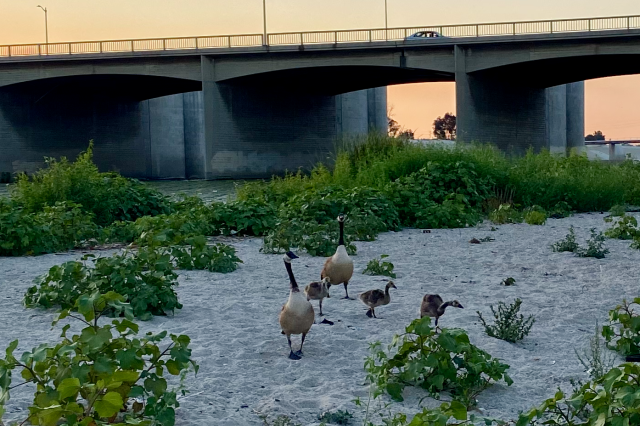
Tyler Hayden
Birds waded, waddled, pecked, and preened up and down the river.

Ricardo Inostroza
Shorebirds of all feathers–black-necked stilts, terns, gulls and Canada geese–settled down for the night as the bats took flight.
1 of 1
Birds waded, waddled, pecked, and preened up and down the river.
Tyler Hayden
Shorebirds of all feathers–black-necked stilts, terns, gulls and Canada geese–settled down for the night as the bats took flight.
Ricardo Inostroza
It started by noticing a red bird. “I thought I was going crazy,” Aubrey says. He’d never noticed it before, his family hadn’t noticed it (he showed them pictures), but once he saw the red-headed house finch, he couldn’t stop seeing it everywhere. “I was under the misconception that there was no wildlife living in L.A., but there’s just an abundance of color around us, and it led me down a rabbit hole.” That rabbit hole led him to NHM’s Instagram account, Wild L.A. (NHM's book on urban nature), studying jumping spiders in his yard (and documenting them in amazing videos) and to standing “beneath this bridge where cars were passing by, wondering how many knew there were bats.”
“I thought they would be aggressive,” Moses Aubrey says. “They weren’t.” In fact, bats are surprisingly social, often sharing roost space with other bats and sometimes even species of birds.
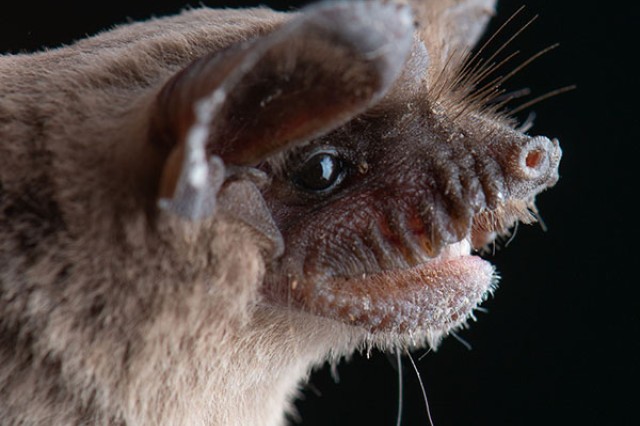
José G. Martínez-Fonseca
Identified in the Backyard Bat Survey, the Mexican free-tailed bat (Tadarida brasiliensis) was likely one of the species we tallied flying into the L.A. night.
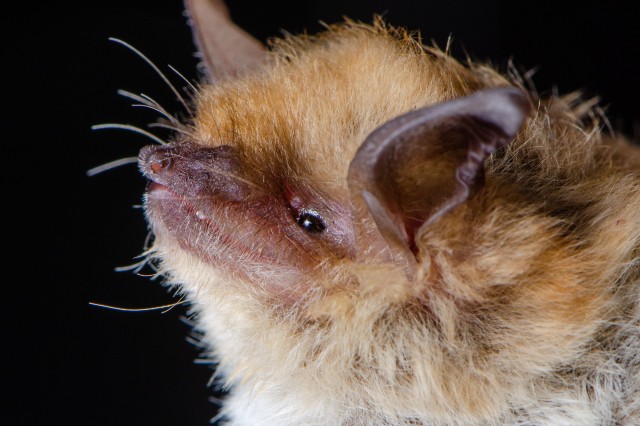
José G. Martínez-Fonseca
Yuma myotis (Myotis yumanensis), another possible bat candidate and one of the bats recorded in the Backyard Bat Survey
1 of 1
Identified in the Backyard Bat Survey, the Mexican free-tailed bat (Tadarida brasiliensis) was likely one of the species we tallied flying into the L.A. night.
José G. Martínez-Fonseca
Yuma myotis (Myotis yumanensis), another possible bat candidate and one of the bats recorded in the Backyard Bat Survey
José G. Martínez-Fonseca
Seeing the Unseen
Greater visibility affects the well-being of animals and humans. Many people found a sense of peace in nature during these tumultuous times. Ricardo Inostroza had found solace since childhood. “I was the green kid, LGBTQ, that’s the main reason I came to this country as a refugee.” The natural world offered acceptance and a safe space, leaving an indelible mark on him for the rest of his life. “There, as a kid, I wasn’t pushed, teased. Animals wouldn’t make fun of me.”
For him, participating in community science and conservation is a matter of giving back. “I need to be visible, probably there’s another Ricardo there who has all this love, and passion but is afraid. That’s why it’s important to represent. I want to be the role model I didn’t have for kids or other adults.”
"I used to look at the L.A. River as an eyesore, but not anymore. Now I look for the oasis, so full of life. Now I look for animals," Inostroza tells me when we catch up after the count. Passing in the blur of a commute, the River feels like a leak running down an alley, but not on foot. Running water and resulting greenery attracts flocks of terns, charmingly irate geese, black-necked stilts, and who knows what else behind the reeds, all of it virtually invisible to us until we got our feet wet that evening.
City Species
The city lights flicker on in the distance as night blankets the river and the darkness hides whatever bats might still be descending. Rachel makes a final round to officially end the count. Rachel and I take Debbie's hands to safely cross the deepest part of the river, and we meet up with Ricardo and Moses on the banks.
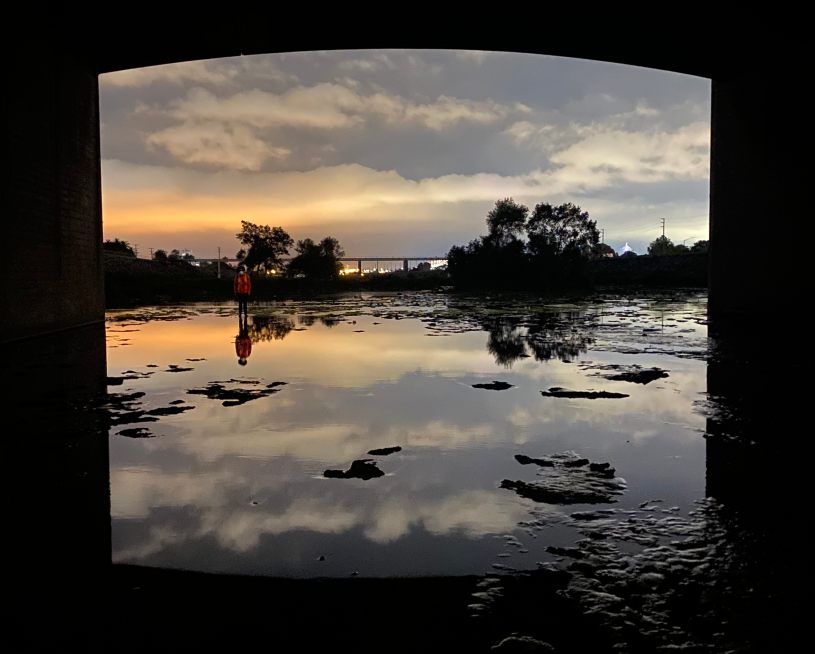
On the other side, we recount what we saw, tallying our numbers to add to the data set. Our counts will help inform scientists about the bat populations' habits and the surrounding community about their night-time neighbors.
Some bats move into the swallows' nests after those birds leave for their famed migration, but Rachel tells us that some birds share their space with bats, and multiple species of bats have been known to share roost space as well. It's surprising somehow to think of different species sharing a den, but then it shouldn't be. Our steel and concrete structures offer opportunities to some species even as they push others out. We’ll never really know what’s going on unless we take the time to look closely.
Driving home, the roost count could have been a dream, except for the smell of my boots and the knowledge that any of us could visit that dreamscape anytime. It's a lot of things: an adventure, fieldwork, community science, but having talked to everyone in our group, I think Rachel said it best: "Bringing together whole different folks from different backgrounds to the L.A. River and having people come together over a shared weird interest looking for nocturnal animals under a bridge is a beautiful thing."
